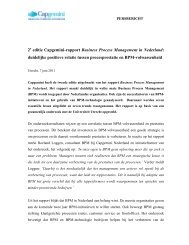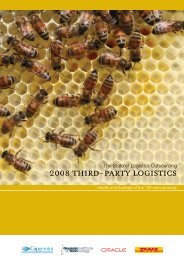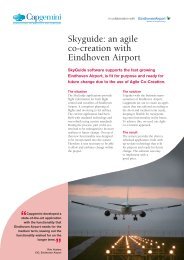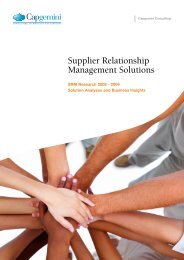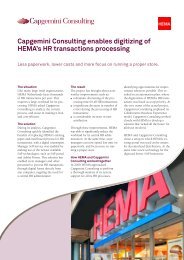IT transformations - Capgemini Consulting Nederland
IT transformations - Capgemini Consulting Nederland
IT transformations - Capgemini Consulting Nederland
Create successful ePaper yourself
Turn your PDF publications into a flip-book with our unique Google optimized e-Paper software.
are not active in are “contestable”, and<br />
that they control the relatively scarce<br />
or unique parts.<br />
In the following sections, a guide<br />
on how to create or maintain an<br />
industry bottleneck is provided. A<br />
way to understand how and why the<br />
competitive environment is changing,<br />
why this matters, and how companies<br />
can respond is offered and in addition<br />
some specific steps that managers<br />
can take to be more effective in these<br />
increasingly competitive conditions<br />
are suggested.<br />
Redefining sectors to create<br />
architectural advantage<br />
Research has identified three tactics<br />
that companies employ to dominate<br />
within an industry architecture.<br />
Enhance mobility across the value<br />
chain<br />
First, companies can enhance<br />
mobility in the parts of the sector<br />
where they do not compete – while<br />
collaborating closely with the firms<br />
involved. For example, Apple does not<br />
physically produce any components<br />
for the iPod. Instead, it retains<br />
a small, tightly controlled set of<br />
suppliers who are given substantial<br />
parts of the value-add, but also know<br />
they may be replaced at any time.<br />
Apple becomes dependent on its<br />
collaborators to an extent, but these<br />
dependencies are asymmetric; their<br />
partners always need them more.<br />
Toyota has a similar approach with<br />
its suppliers, making sure that there<br />
is potential mobility in the sector.<br />
Its top-tier suppliers make more<br />
profit than those in lower tiers. But<br />
they know they must be extremely<br />
open with Toyota regarding their<br />
cost structures to stay in the top<br />
tier. Toyota actively encourages<br />
competition between suppliers to<br />
ensure its vehicles become better<br />
and cheaper: it works closely with<br />
its suppliers but its rules make sure<br />
suppliers never forget that they are<br />
replaceable 6 .<br />
Create the conditions to become a<br />
bottleneck<br />
Companies can also change rules<br />
and institutions to become the<br />
bottleneck. The key is to become the<br />
least replaceable part of the sector (or<br />
a set of interconnected companies)<br />
so that it can be controlled without<br />
even owning it. This requires taking<br />
a view of the whole sector, identifying<br />
how to become less replaceable, then<br />
seeing how to change the nature of<br />
the relationships. Identifying and<br />
bringing the value-add to the other<br />
industry participants is vital.<br />
Microsoft used alliances, standards,<br />
and industry conventions to become<br />
the bottleneck and achieve industry<br />
dominance. The industry made it<br />
easy to be a PC manufacturer, but<br />
harder and harder to compete with<br />
Microsoft. The same strategy was<br />
behind Apple’s ability to create a<br />
dominant position for itself in digital<br />
music. Apple’s control of iTunes<br />
locked customers in through its<br />
Digital Rights Management (DRM)<br />
strategy. Files that were compatible<br />
with iPod only played on iPods or<br />
PCs. Playability on computers induced<br />
users to stick with iTunes. Crucially,<br />
the incompatibility of iTunes with<br />
other portables creates dependencies<br />
on Apple, thus Apple can safely<br />
retreat from hardware production,<br />
knowing that it dominates the<br />
bottleneck in the digital music sector.<br />
While Apple has moved away from<br />
using DRM as a tool for building a<br />
dominant position, nevertheless, the<br />
role that it played in building Apple’s<br />
dominance cannot be overstated. The<br />
skill of shaping the environment and<br />
of selling the vision is a key driver of<br />
success in companies such as Apple.<br />
6 Michael G. Jacobides and David C. Croson, Small Numbers Outsourcing: Efficient Procurement Mechanisms, Working<br />
Paper, London Business School, November 2010.<br />
86



